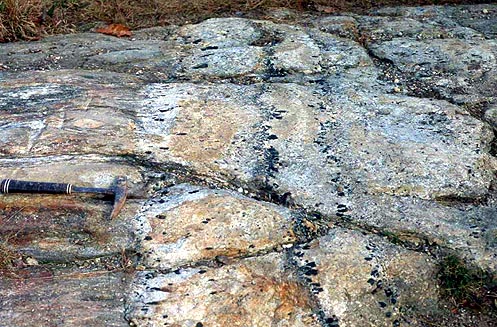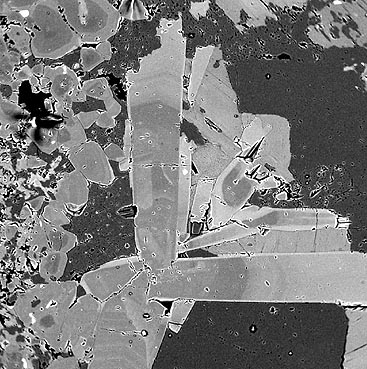|
(revised 09/04/2003)
Dr. Dipak C. Pal (Lecturer, Department of Geological Sciences, Jadavpur University, Kolkata 700 032, India) has submitted two questions that stem from his studies of pegmatites in the Bastar-Malkangiri Tin Belt, central India. Both questions pertain to the role and evidence for a dominantly aqueous vapor phase in the internal evolution of pegmatites. For the other question see http://www.minsocam.org/MSA/Special/Pig/PIG_CQ/PIG_CQ_pal_sat.html. This is the web page for question #2. These questions address the nature of the pegmatite-forming process. Dr. Pal has requested responses that will clarify the issues he has brought up. Please feel free to comment on either or both questions. Question #2: Pegmatite crystallization - an open or closed system? Can it be open to influx of metamorphic/meteoric fluid from external sources, and at what stage? What is the evidence of pegmatite becoming open to the influx from external system(s)? Does the formation of zoned pegmatite behave completely as closed system throughout its entire history of crystallization? If not, when and how long does it remain open to influx from an external system? If the influx of convecting meteoric or metamorphic water into the pegmatite during its crystallization is permitted, then what will be the fate of those fluids in the pegmatite? Will they be trapped as primary fluid inclusions in crystallizing minerals? In that case, such inclusions may possibly be misinterpreted as the evidence of water saturation in the first instance (editor's note: this refers back to question #1 - to saturation of the pegmatite melt via decompression or crystal fractionation). How can one distinguish fluids from external sources from those that are actually exsolved from the pegmatitic melt? Stable isotope characteristics may be one way to distinguish them. Is there any other way? If a pegmatite becomes open to the influx from external system(s) at different stages of its crystallization, what is the field evidence in favour of that? David London replies: I'll take a stab at Dipak Pal's question #2, as I think it is easier to address than is question #1. There are at least three manifestations of open-system interactions that I am aware of from my own work and that of others: (a) multiple or continuous injections of new pegmatitic melt through the same conduit, giving rise to multiple stages of pegmatite growth; (b) influx of externally derived fluid components from host rocks at the onset of crystallization; and (c) expulsion of pegmatitic fluids to host rocks toward the end of consolidation, with or without reflux of external components into the pegmatite. Multiple injections. Multiple injections evidenced by crosscutting relationships within the same pegmatite group are prevalent in pegmatite complexes near their granitic source. Jahns and Tuttle (1963) alluded to this fact in their discussion of aplite-pegmatite relations, but Ed Duke (Duke et al., GSA Bulletin 100, 1988) depicted it well in some accurately rendered drawings. In more distal dikes, evidence for multiple injections is sometimes construed from repetitions of paired pegmatite-aplite or other zonal features within the same body. For example, Fig 1 here (near Haddam, Connecticut, USA) shows a concentration of black tourmaline along a pegmatite dike margin with muscovite schists, and then another bilaterally symmetrical zone of "marginal" or "border-zone" tourmaline along the central portion of the dike. The interior zone is suggestive of re-injection of pegmatite melt, and the creation of another black tourmaline margin.
Figure 1. Influx of External Components. Ordinary black tourmaline, which in granites and pegmatites is a schorl-olenite-foitite solid solution, is very insoluble in peraluminous pegmatites at low temperature. Hence, pegmatites should not be able to precipitate much tourmaline upon injection and crystallization, yet tourmaline-rich margins such as in Fig. 1, and in much more spectacular examples elsewhere, are common. I suggested (London, 1990) that the tourmaline-rich borders of pegmatites arise by mixing of pegmatite-derived components (Na, B, Al, Si) and wallrock-derived components (Mg, Fe). In general, large masses of tourmaline associated with granites and pegmatites mark the site of fluid mixing -- influx of wallrock components makes tourmaline within pegmatites, expulsion of pegmatite-derived components promotes tourmaline metasomatism of the host rocks. Fig. 2 (from London and Manning, 1995) illustrates the influx of slate-derived mafic components into a thin pegmatite dike at Megiliggar Rocks, south Cornwall, UK. Perpendicular to the slate-pegmatite contact (along the left-hand margin of the photo), tourmaline manifests fine-scale zonation and generally Mg-rich compositions (dark zones) that are typical of hydrothermal tourmaline from open fracture filled veins. As the pegmatite border crystallized and sealed, the tourmaline drew what Fe was present from the magma, then when exhausted tourmaline crystallization ceased.
Figure 2. In an entirely different study, Thomas and Spooner (e.g., PACROFI III, 1992; GCA, 1990) identified fluid inclusions containing reduced carbonaceous components mostly near the margins of the Tanco pegmatite, but they and I (London, 1986) documented more oxidized CO2-rich inclusions within the body. The sulfide-bearing amphibolites are a likely source for the reduced components, which mostly oxidized to CO2 within the pegmatite. Late in the history of consolidation, pegmatites again appear to be open to an influx of some of the same external components. Calcic phases including epidote, stellerite, laumontite, stilbite, danburite, and smectites appear in late-stage cavities. Though Jahns thought this "'miniflood' of calcium" stemmed from alteration of early-formed oligoclase, I think it comes from the host rocks. At Tanco, I documented that the latest (lowest-temperature) and most saline fluid inclusions in quartz were rich in Ca, Mg, and sulfate, and I suggested that those components originated from the host amphibolites. Tourmaline in miarolitic cavities evolved from elbaite back to Fe-rich foitite (e.g., see work of Pezzotta, Aurisicchio, et al. on Elba), and I suggest that this, too, records an influx of Fe form the wallrocks. Wallrock Alteration. Many PIGs are aware of the types of wallrock alteration that occur around pegmatites. These include the formation of metasomatic tourmaline, biotite, holmquistite, epidote, calcite, Mn-garnet, muscovite, and clay minerals that, collectively, indicate temperatures appropriate for the greenschist-zeolite facies of metamorphism. In my experience, wallrock metasomatism from pegmatite-derived fluids is pervasive around large, highly fractionated pegmatites, sporadic around small, moderately to highly fractionated pegmatites, and absent around unfractionated pegmatites of just about any size. Wallrock metasomatism always seems to mirror the latest-stage internal units of pegmatites. Hence, tourmalinization of host mafic rocks is prevalent only around "blow-outs" from gem pockets in the San Diego County (CA) pegmatites, but is negligible along the lengths of these highly fractionated dikes. At the Tanco pegmatite, George Morgan and I (1987) documented that the innermost pegmatite units controlled the spatial distribution of complex metasomatic assemblages in wallrocks. For example, holmquistite formed above and below large central bodies of spodumene + quartz; Cs-rich biotite was located above the giant pollucite masses; tourmalinization was nearest to tourmaline-rich albitic rocks. An important point -- these latest and most evolved units were in place as or before the first record of pegmatite-derived fluids was recorded in the wallrocks. Stable Isotopes. I'll hope that others who practice this work will chime in. My familiarity with a couple dozen or so papers and abstracts on stable isotopes (H, O, B) is that some pegmatites manifest interactions with host rocks, some don't. Overall, I'd say that the stable isotope systematics are peculiar. Different coexisting mineral pairs can give very different temperatures of "equilibration", and those temperatures range widely between magmatic and subsolidus conditions. Darby Dyar (Tourmaline 97) reported two very interesting cases from Maine where temperatures of mineral formation/equilibration based on dO18 appeared to INCREASE from pegmatite margins to cores. I think most practitioners in this field explain peculiarities and low temperatures of equilibration as the results of selective recrystallization of one phase or another, but I'm not so convinced. You can submit questions and comments in electronic formats only to Dr. David London at |


